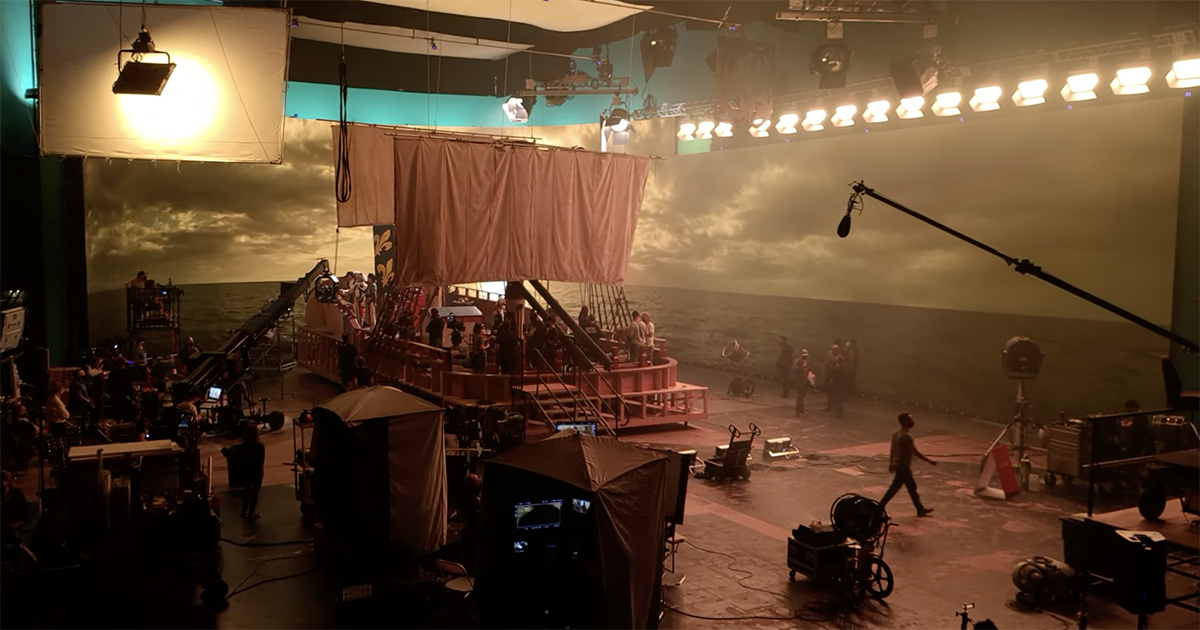
Image courtesy of Stargate Studios
TL;DR
- Sam Nicholson, founder and CEO of Stargate Studios, was interviewed at the 2023 NAB Show by Erik Weaver, director of ETC’s Adaptive Production project.
- Nicholson says virtual production is superior to green screen but location work can still be better than a stage
- We have a lot to learn about how to light in a volume, he says. Nicholson also warns against directors changing their mind about a volume shot after the event and instead to plan better ahead of time to avoid costly reshoots or post work.
We’ve only just scratched the surface of how to use light from virtual production displays, says Sam Nicholson, founder and CEO of Stargate Studios.
Lighting the scene using LED screens is a big top of discussion in the unions right now, he says. Because it is technology that is neither designed as a light but is not purely a screen since scenes can be illuminated with it.
“I’m not going to take sides in that argument. But that’s something that we’re dealing with both playback and lighting right now, and trying to define them. It’s a new technology that’s right in between, nobody knows what to do with it.”
Nicholson is one of Hollywood’s leading virtual production and visual effects creatives. With nearly forty years as a visual effects supervisor, DP, director, and now virtual production supervisor, Nicholson and his company, Stargate Studios, have combined the latest in LED technology with their proprietary “ThruView” lighting system.
Interviewed at the 2023 NAB Show by Erik Weaver, director of ETC’s Adaptive Production project, Nicholson explained that VP is the process of capturing the real world and making it usable in such a way that it’ll play back in a volume.
“Virtual production is fabulous. [But] if you can afford to go to Rome to shoot live action, and get some great pasta, and have a great time, you know, go to Rome. If you can’t, then send a small team to capture Rome, the Vatican, and bring the data back [to your volume], and now you can control the situation.”
In his presentation, Nicholson talked about his journey with creating in-camera VFX, including working with legendary Doug Trumbull on Star Trek: The Motion Picture. He described creating the effect of a 60-foot high column of light shot in-camera and in real time on stage for director Robert Wise.
He worked through the green screen period, which he described as one where “basically the crew would get a lobotomy going in. Nobody knows what it’s going to look like. How do you light it? How do you light for daylight if you can’t see daylight behind me? Where’s the sun? Green screen was very messy, because all the actors didn’t know which way to look. Really bad for the actors and very difficult for a director of photography, and very frustrating for the director.”
He later worked on the groundbreaking TV series 24, elements of which were shot on green screen.
“It was kind of a game changer, because all of a sudden, they said it’s a lot cheaper to bring the location to the actors than taking the actors to the location. It’s very difficult to shoot in Washington DC. when you’ve got to get a permit from one [multiple] groups to shoot anywhere.
“With green screen the actors didn’t have to be out all night. But dammit, we hate being on green screen. I mean, we had Kiefer Sutherland, like, walk off the set because he hated shooting on green.”
Virtual production solves a lot of these problems, giving actors a cue as to the environment they are in. But it is still very early days in the technology’s development.
Covering dialogue scenes with a shallow depth of field on a longer lens is ideal, but the wider the lens the more difficult it gets.
In addition, and perhaps the biggest challenge, is that virtual production isn’t as flexible as you might be led to believe. If a director changes their mind about a shot after the event it remains difficult to fix that shot with all the backgrounds baked-in in post.
“If you have a director who doesn’t know what they want or you’re on a short prep schedule, don’t try to do virtual production because you’ll get burned. Be really aware that you don’t have an alpha channel. There is no matte. So you’re gonna wind up with a big old rotoscoping bill if you change your mind.”
His advice? Prep, prep and prep. “Virtual production is not a panacea. It’s a great new tool that does certain things like reflective objects really well. But it does other things horribly, like changing your mind.”
Related Reading
- Virtual Production But Sort of Real Pirates (?): Making “Our Flag Means Death”
- Merging Reality with Fantasy: Virtual Production & Visual Effects on HBO Max’s “Our Flag Means Death”

